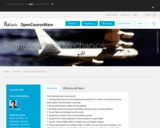
Course Contents 1. Turning performance (three dimensional equations of motion, coordinate systems, Euler angles, transformation matrices)
2. Airfield performance (take-off and landing)
3. Unsteady climb and descent (including minimum time to climb problem)
4. Cruise flight and transport performance
5. Equations of motion with a wind gradient present
6. Equations of motion applied to various phases of space flight
7. Launch, Vertical flight, delta-V budget, burn out height, staging
8. Gravity perturbations to satellite orbits, J2 effect for low earth orbit satellites, J2,2 effect for Geostationary Earth Orbit sattelites leading to contribution in ï„V budget
9. Patched conics approach for interplanetary flight, gravity assist effect / options for change of excess velocity (2d, 3d), Launch, in orbit insertion.
Study Goals 1. Integrate fundamental disciplines (aero, power and propulsion, mechanics..) to describe the kinematics of aerospace vehicles satisfying real world constraints
2. Derive equations of motion for elementary flight and mission phases (climb, turn, cruise, take-off, launch, orbit)
3. Derive analytical expressions for optimal performance (steepest turn, Breguet Range, patched conics, J2, maneuvers )
4. Determine pros/cons of multi-stage launchers.
5. Assess sun lighting conditions on a satellite.
6. Determine the influence of wind (gradient) on aircraft motion and performance.
7. Develop the theory to describe an interplanetary trajectory as a succession of two-body problems, and apply this concept to real missions.
- Subject:
- Applied Science
- Material Type:
- Full Course
- Provider:
- Delft University of Technology
- Provider Set:
- TU Delft OpenCourseWare
- Author:
- Dr.ir. M. Voskuijl
- Date Added:
- 08/14/2014